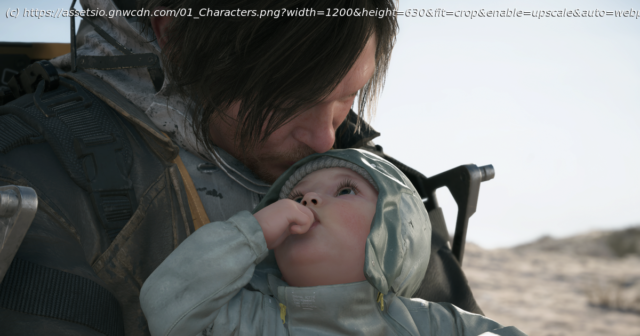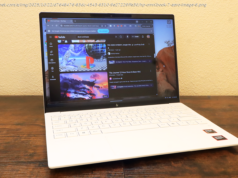Eurogamer’s big preview of Death Stranding 2: On The Beach, detailing a heavy influence of Kojima’s Metal Gear Solid games.
The dark main hallway of Kojima Productions feels like a cinema corridor. Its black walls are adorned with giant film posters for Death Stranding, with side routes leading to meeting rooms and facilities rather than screens. Along another section of wall are a series of signed plaques and polaroids from various stars of film, games, music, and beyond who have each visited the studio. It’s as if the very walls themselves are taking us through Hideo Kojima’s mind — or are simply an extension of his social media feed.
Kojima’s work has always had a strong influence of cinema running through it, Metal Gear Solid and Death Stranding in particular. But in the office that influence is made explicit. Beyond the trophy cabinets celebrating his life’s work lies a collection of recording suites, scan and motion capture rooms, a THX certified sound studio, and more. This is film production for a video game, all in one place.
There’s a sci-fi edge to it all too. The studio as a whole is starkly monochromatic, from the deep black walls to the sleek, pristine kitchen area. Then there’s the Ludens Room: a blinding white ode to the Kojima mascot with a single statue at its centre, which extends to infinity through mirrored walls. From here, a secret doorway takes us to a gallery of Death Stranding artwork and paraphernalia, while another secret doorway leads to an all-white circular meeting room like something out of 2001: A Space Odyssey. Another meeting room features a video feed of the Ludens Room on the wall, into which Kojima himself occasionally appears. He’s always watching.
I’m here in the studio to play an intense 30 hours of Death Stranding 2, what Kojima described as a Death Stranding «bootcamp». And if the studio feels like a reflection of the creator, so too does the game: his past and present, his taste in film and music, and his anxieties around mortality and the need for human connection.
The first Death Stranding game was Kojima let loose. After a career defined largely by one series — Metal Gear Solid — his acrimonious split from Konami led to the creation of his own studio and a brand new, divisive game full of typical Kojima-isms: a bizarre sci-fi world, advanced technology, and cinematic excess.
For some, Death Stranding offered a profound take on the afterlife and a desire for community that pre-empted the Covid-19 pandemic, all presented in a meditative, mournful tone. For others, it was a nonsensical walking simulator of endless acronyms and laborious gameplay. Either way, it was certainly a clear step away from the Metal Gear Solid games from which Kojima earned legions of fans.
What players can perhaps agree on is that the game featured outstanding art design from longtime collaborator Yoji Shinkawa; had exceptional use of pensive, haunting music at key moments; and innovated with its asynchronous online connectivity.
Six years later, post-pandemic, Kojima returns with Death Stranding 2: On the Beach. What’s new in this sequel? How has Kojima responded to his critics? And does the story finally make any sense?
It’s immediately apparent Kojima has put that production studio to good use. The game’s opening is visually extremely impressive as it seamlessly blends from cinematic to gameplay, the skin textures on protagonist Sam Porter-Bridges’ face are beautifully realistic, and as he descends across a rocky, barren landscape and the camera pans out for perfect framing, a grandiose song from Woodkid plays that’s all expressive strings and pounding drums. The sun sets, the rain comes. And all this on a base PS5 in silky smooth performance mode.
Before this there’s an optional recap of the first game, but its handful of stills and voiceover are barely sufficient to fully explain its weird intricacies. This is a sequel for those with intimate knowledge of the first game, though with all that exposition now out of the way Kojima is able to focus on telling a story to answer remaining questions instead of endless explanation. This is a much pacier experience as a result that swiftly gets players into gameplay — in under 20 minutes Sam’s off on his first big mission and from there key plot beats are sparsely spaced out across playtime.
There’s a new addition to the sequel that also aids the pace: the Corpus. As with the likes of Avowed and Final Fantasy 16, the Corpus is an in-game glossary that can be opened at any time to recap plot points and read about characters and places. It’s not only an essential resource, it ensures Kojima’s script is tight and concise, extraneous detail saved for later reading.
As for the plot itself, the basics are (so far) comparatively straightforward. The 30 hours I played for preview represent around 40 percent of the story, but I won’t be spoiling anything here beyond a few points on the premise — in part I’m not allowed to (be it plot, special guests, or musicians), but I wouldn’t want to anyway. It’s best experienced with little knowledge to fully appreciate its eccentricities, though everything I played can be seen in last year’s State of Play trailer. Over that time the plot provided plenty of intrigue and unanswered mysteries, but I still fear a five hour lore dump in the game’s final moments could upturn the plot as Kojima did before.
Still, it begins 11 months after the first game, with deliveryman Sam (Norman Reedus) in hiding along with his BB, Lou. After connecting America to the chiral network, deliveries are now completed by the Automated Porter Assistant System essentially, Sam’s job has been taken over by AI. Instead, he now leads a comfortable life with his adopted daughter. That’s soon disrupted by the return of Fragile (Lea Seydoux), now running new company Drawbridge, who sends Sam out on a mission to connect Mexico to the chiral network. After crossing the Mexican border (yes, there’s a wall), Sam’s mission soon takes him across the globe (for…reasons) to the outback of Australia, where the bulk of the game appears to take place.
Even with its more comprehensible plot, Death Stranding 2 still has its fair share of weirdness and a lack of subtlety — it’s a Kojima game after all. This remains a game about shadowy beings crossing over from the land of the dead that only half-dead babies can see; there’s a flying cat made of tar, a woman who can summon rain, a talking stop-motion animated puppet, and a very cool nod to Splatoon; and it’s all interspersed with snippets of flashback and one particular nightmarish firework sequence that’s one of the most visually spectacular moments I’ve ever seen. Within all that, there’s plenty of room for heavy-handed metaphor and symbolism: Sam begins the game wearing a cap with the words «why me?» as his quest begins, while the names of Kojima’s characters — Dollman, Rainy, Tomorrow — are all too literal.






